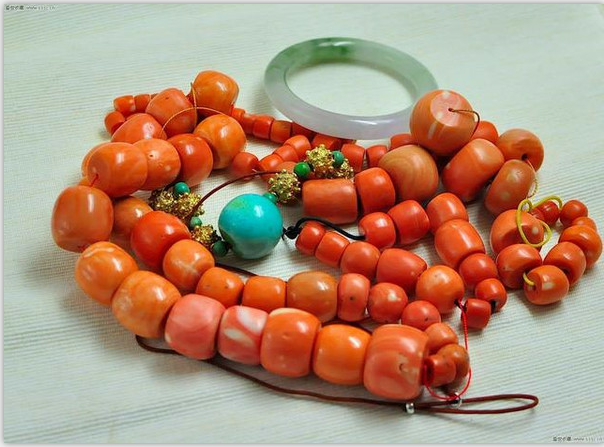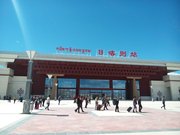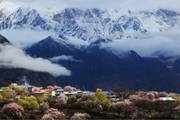Travel to Tibet: Q&A
What do you need to know when you come to Tibet for the first time? Here are some tips for the first-timers.
1.) Do I need to do exercises before going to Tibet?
A: The thing people are most worried about when traveling to Tibet is the altitude sickness. Be sure to rest a week before you travel and do not do more exercises.
2.) Who should not go?
A: The environment of the Tibetan Plateau requires good physical conditions. Those with the following types of diseases should be particularly cautious:
i. Individuals with cardiac, blood or cerebrovascular diseases.
ii. Individuals with any kind of respiratory sickness.
iii. Individuals with epilepsy, schizophrenia, or uncontrolled diabetes.
iv. Individuals who have suffered from high altitude sickness, edema, cerebral edema, or high altitude cardiac illness.
v. Women in late stage pregnancy
vi. Individuals who are seriously ill, are running a fever or have respiratory infections.
3.) What are the symptoms of high altitude sickness?
A: The effects of high altitude sickness vary from person to person depending on one's own physical conditions, ranging anywhere between the mild to the severe.
Minor effects may include headache, ringing ear, asthma, bodily fatigue, and insomnia, all of which will usually naturally dissipate; severe effects may include profuse vomiting, facial discoloration, and diarrhea. In these sorts of situations it is best to take medication or seek medical attention in order to avoid serious detriment to one's health.
4.) How can I prevent and alleviate the effects of high altitude sickness?
A: There are many options for high altitude sickness medication, among which the most well known is roseroot, which is available in tablet, liquid and dissolving powder form. The medicines should be taken about 10 days prior to traveling to Tibet, and they will not be very effective if taken after arrival.
Other ways to the alleviate elevation sickness include taking American ginseng, or inosine tablets/liquid, Bufferin or glucose for headaches. In the wake of elevation sickness, it's important to rest, reduce body movement and strain and eat/drink light and clear foods/liquids. If the symptoms are serious, one can inhale oxygen.
5.) Why can't I go to Tibet if I have a cold?
A: When you have a cold, the lungs and trachea are enflamed, bodily resistance is low, the air is both thin and dry and a cold can easily degrade into pneumonia, pulmonary edema or bronchitis. If you have a cold, it is best to recover completely before heading out on your trip.
6.) When is the best time to go to Tibet?
A: May to October is the best season in Tibet, since it is comfortably warm but not scorching. However, this is also the peak season for Tibet tourism, and there are many travelers and travel costs are also high. From November to the following April it's relatively cold, but the sun makes things warmer during daylight hours. There are very few tourists during this time, but one can really have an authentic experience of Tibet.
7.) How can I get into Tibet?
A: There are three ways to get into Tibet: by automobile, by train, or by plane. Going by automobile takes a long time and consumption expenditures are relatively high, but it's the most effective option for adjusting to the high altitude. Going by train takes a relatively short amount of time, expenditures are low and the body can also gradually adjust to the elevation, so the chances for altitude sickness are smaller. Going by plane is the fastest way, but the change in elevation is drastic, thus posing the highest chance for altitude sickness.
8.) Which places in Tibet require the frontier permit?
A: The following places require the frontier permit:
Shigatse City's Drongpa County, Saga County, Nyalam County, Tingri County, Kangma County, Yadong County, Gangba County, Dingkye County, Gyirong County;
Lohka Prefetcure's Cona County, Luntse County, Lhodrak County, Nakartse County;
Nyingchi City's Mainling County, Nang County, Zayu County, Medog County;
Ngari Prefecture's Burang County, Zhada County, Rutog County and Gar County.
If you have a valid passport with an exit visa, simply showing your passport will be enough for visiting some places. For specifics please consult the Tibetan Frontier Division.
9.) What do I need to be aware of when I first arrive in Tibet?
A: When you first arrive in Tibet, it's important to rest. Walk around the city area and let your body adjust to the elevation. Generally speaking, it is recommended that you don't take a shower the same day you arrive. Rest early and drink lots of water and eat light food. The air on the plateau is relatively dry. And if nose bleeding is an issue, one can see a doctor to apply ointment to lubricate the nasal cavity.
10.) How is the weather like in Tibet during the summer? What should I wear?
A: Summer in Tibet is comparatively fresh and cool. Daylight hour temperatures are basically around 25℃ and at nighttime it drops to around 10℃. Be sure to wear long pants and long-sleeved shirts and apply sunscreen during the daytime, and when night falls, you can simply put on a jacket. July and August is the rainy season in Tibet, so it is better for you to bring an umbrella or a raincoat.
11.) How can I protect myself against strong sunshine in Tibet?
A: The Qinghai-Tibet Plateau is relatively dry with very strong ultraviolet rays. . When you're outdoors in Tibet, aside from wearing long shirts and pants, brimmed hats, sunglasses and face masks, you can also apply high-proof sunscreen lotion to your body.
12.) How about going to Tibet in winter? Is it extremely cold there?
A: Winter in Tibet is very beautiful. Temperatures range from -10 ℃ to around 10℃. Because there's a lot of sunshine during the daylight hours, it's very warm. In most areas except Ngari and Nagqu, simply wearing a heavy down jacket is sufficient. During this time there are comparatively fewer tourists in Tibet and travel expenses are also rather low. With the exception of a few scenic spots which may be closed due to heavy snow, there are still many places that you can go and visit.
13.) What can I do in Tibet during winter?
A: The most popular thing to do in Tibet during winter is to walk around the Lhasa city. You can go to the Potala Palace Square, sunbathe at the entrance to Jokhang Temple, and walk around the Barkhor Street. If the weather is good and the passes are not closed, you can even go to Namtso, Mount Qomolangma,or bathe in the hot springs.
14.) Can I go to Mt. Qomolangma or Namtso Lake in winter?
A: In winter when the weather is nice, you can go to these places if the passes are not closed, but you cannot stay overnight due to the low temperatures, and the hostels and restaurants in these areas will be closed down for the season. If you encounter a road closure, you will not be able to go through.
15.) How is the cell phone signal in Tibet?
A: Most of the areas in Tibet have cell phone coverage except for the extremely remote areas. If you wish to travel to these locations, you'll have to make some preparations.
16.) Which cities in China have direct flights to Lhasa?
A: Beijing, Shanghai, Guangzhou, Chengdu, Chongqing, Kunming, Lanzhou, Xi'an, Xining, and Dechen.
17.) How many airports does Tibet have?
A: All together Tibet has four airports: Lhasa Gonggar Airport, Nyingchi Mainling Airport, Chamdo Bangda Airport and Gunsa Airport. You can fly into any airport according to your own preferences.
18.) Which cities have direct trains to Lhasa?
Beijing, Shanghai, Guangzhou, Chengdu, Chongqing, Xining and Lanzhou all have direct trains to Lhasa. The train from Beijing to Tibet runs every day, and those from other cities in the country run every other day.
19.) Is it difficult to buy a train ticket to Tibet?
A: It is relatively difficult to buy a train ticket to Tibet throughout the year, especially during peak season for travel. It's best to book your tickets in advance. Buying tickets to leave Tibet during the off season is okay. No matter going to or leaving from Tibet, if you cannot find a ticket at all, a travel agency service will be able to assist you.
20.) What are the dining options in Tibet aside from Tibetan cuisine?
A: The most common type of food in Tibet aside from the local cuisine is Sichuan food, but there are also Nepalese, Indian and Western dining options. There is no KFC, Pizza hut or McDonald's in Tibet and the only fast food option is Dicos.
21.) What is Tibetan food like?
A: The most commonly seen foodstuffs in Tibetan cuisine, derived from the local farming industry, are: carrot and yak meat stew, lamb, silverweed cinquefoil root rice, Tibetan barley bread(zanba, or known as roasted highland barley flour), catipillar fungus and matsutake chicken, buttered highland barley, yogurt mixed with rice, beef curry rice and dried beef jerky.
22.) What kind of Tibetan snacks are there in Tibet?
A: Tibetan snacks are very unique, including Tibetan noodles, Tibetan dumplings, Tibetan steamed stuffed buns, sweet tea, buttered tea, bean jelly, cold noodles, friend potato strips, yak yogurt, beef paddy cake, milk dregs and yogurt ice cream.
23.) Is buttered tea and sweet tea good to drink?
A: Buttered tea and sweet tea are both common beverages in Tibet. The sweet tea goes down easy, and there are those who feel at the taste of the buttered tea has somewhat of a gamey flavor; however, the buttered tea does help with the elevation sickness to a certain extent, so it'd be wise to at least try some.
24.) Is it okay to set up a tent and camp out along the river in Lhasa?
A: Usually it's okay, just be sure that your tent and sleeping bag are able to withstand very low temperatures because night time in Lhasa is very cold.
25.) Is it convenient to find internet access in Tibet?
A: In Lhasa, hotels all have wireless internet, and many hostels, bars, and restaurants have wifi as well. There are also many internet cafes which charge around 3-4 yuan per hour.
26.) Can I use coinage in Tibet?
A: In Tibet you can only use paper currency.
27.) What is there to do in Nyingchi?
A: Nyingchi is known as "Switzerland in the East" and the natural scenery is very beautiful. The main scenic spots are Basum Co Lake, Namjagbarwa, the Yarlung Zangbo Canyon, Nanyigou Valley, Lulang, the thousand-year-old Xiuba fortress, the Taishao ancient city, and the Midui glacier.
This place is still home to the Monba, Deng people and Lhoba people, and you can experience their unique cultures.
28.) What should I do in the Ngari area?
A: The Ngari area is vast, where there is Mt. Gang Rinpoche, the sacred lake Mapham Yutso, the "ghost lake" Lannga Co, Pangong Tso Lake and Mt. Nemonanyi, all of which are sacred Tibetan pilgrimage sites. There is also the Zanda clay forest, the ruins of the Guge Kingdom, and the Rutog rock paintings.
29.) What's the best month to hike to Medog?
A: The best time would be from the end of August to the beginning of October. During this time the weather is comparatively good, there's not much rain, and hiking is relatively safe. From October to May it's very cold, the passes are sealed off by snow and it’s easy to have an accident. June to the beginning of August is rainy season, which is also very dangerous.
30.) How do you get to Mt. Qomolangma from Lhasa?
A: Route 1: take the bus from Lhasa to Shigatse, from Shigatse take another bus or rent a car/driver to Tingri, where you can walk or ride a bike to Mt. Qomolangma.
Route 2: carpool with somebody direct from Lhasa, the fare for each person will be around 1,000 yuan.
Route 3: go with a tour group, the tour usually takes four days. For specifics please contact the tour agency.
31.) Where can I go for the hot springs in Tibet?
A: There are many hot springs in Tibet, the relatively famous ones being Yangbajain hot spring, the Rudog hot spring, and the Dezhong hot spring. Yangbajain is more than 90 kilometers away from Lhasa, which is about 4-5 hours of driving.
The Rudog hot springs are in Maizhokunggar County, and can be reached by taking a bus from Lhasa to Nyingchi. The Dezhong hotspring, also in Maizhokunggar County, have become a popular place for common people and are inexpensive.
32.) How much are tickets to go into the Potala Palace? Are they easy to buy?
A: Every year from the beginning of May or June to the end of October is peak season, and ticket prices to the Potala Palace are 200 yuan. From the beginning of November to the end of April or May the price is adjusted down to 100 yuan.
During off season you can directly purchase the ticket and go to the Potala Palace on the same day. However, during peak season it is relatively difficult to buy a ticket, and as such you'll need to purchase your entrance pass a day in advance.
33.) Can I take pictures in the Potala Palace or other temples?
A: You can take pictures of the Potala Palace from the outside but not from the interior. For other temples usually it's also prohibited to take pictures; however, if you really want to take pictures, you can ask the attendants who work at the temples to inquire if it's permissible or if there are any associated fees.
34.) What do I need to know when I go to a Tibetan temple?
A: When you enter a Tibetan temple, be sure to remove your hat, sunglasses, and abstain from smoking. Don't rub the Buddha statues, browse through the scriptures and ring the bell. Do not casually handle the Buddhist relics or amulets. When you enter the monasteries, walk around clockwise, not counter-clockwise (Bon temples are the opposite).
35.) What is the best season to go to Namjagbarwa? Where is the best observation point?
A: Namjagbarwa is surrounded by clouds in all four seasons of the year. Legend has it that those who actually manage to catch sight of it will have good fortune.
During spring time, the weather is sunny and clear, the clouds are high, the breeze refreshing, and the probability that you'll be able to see Namjagbarwa is the highest during this time.
The best observation point is located at the Sejila mountain pass. Zhihai Village and Dalin Village, the other two observation points, are relatively far away.
Your Comment
Name E-mailRelated News
-
;
-
-

-
Must-buys when traveling to Tibet
TibetanknivesTibetankniveshavelongbeenaprestigioustraditionalcraft.Theyhavealonghistory,auniquestyleandarelovedbytourists.
-
-
-

-
Collectibles not to be missed when traveling in Tibet
Dzi beads are rare gems mainly found in the Himalayan mountain areas of Tibet, eastern Tibet, Bhutan, Sikkim, Ladakh and other places.
-
-
-

-
What to prepare before travelling to Shigatse?
A trip to Shigatse is guaranteed to be one of the most memorable experiences of your life.
-
-
-

-
Travel Guide for Tibet Tour in 2016 (II)
Tibet never fails to allure global travelers to revisit her and explore more in this holy place.
-
Based in Lhasa, Tibet Vista is a Tibet travel agency that specialized in Tibet permit, and Tibet tours for both private and group travelers at a local price!
•4 Days Lhasa City Group Tour from USD 460 •8 Days Everest Base Camp Group Tour from USD 850 •15 Days Mt.Kailash Group Tour from USD 1780 •2016 Tibet Train Tours from Beijing, Shanghai, Chengdu, Xining,etc










